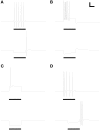A model of electrophysiological heterogeneity in periglomerular cells
- PMID: 23637658
- PMCID: PMC3636461
- DOI: 10.3389/fncom.2013.00049
A model of electrophysiological heterogeneity in periglomerular cells
Abstract
Olfactory bulb (OB) periglomerular (PG) cells are heterogeneous with respect to several features, including morphology, connectivity, patterns of protein expression, and electrophysiological properties. However, these features rarely correlate with one another, suggesting that the differentiating properties of PG cells may arise from multiple independent adaptive variables rather than representing discrete cell classes. We use computational modeling to assess this hypothesis with respect to electrophysiological properties. Specifically, we show that the heterogeneous electrophysiological properties demonstrated in PG cell recordings can be explained solely by differences in the relative expression levels of ion channel species in the cell, without recourse to modifying channel kinetic properties themselves. This PG cell model can therefore be used as the basis for diverse cellular and network-level analyses of OB computations. Moreover, this simple basis for heterogeneity contributes to an emerging hypothesis that glomerular-layer interneurons may be better described as a single population expressing distributions of partially independent, potentially plastic properties, rather than as a set of discrete cell classes.
Keywords: NEURON simulator; acetylcholine; computational model; glomerulus; juxtaglomerular neurons; olfactory bulb.
Figures





Similar articles
-
Secretagogin-containing neurons in the mouse main olfactory bulb.Neurosci Res. 2013 Sep-Oct;77(1-2):16-32. doi: 10.1016/j.neures.2013.08.006. Epub 2013 Sep 2. Neurosci Res. 2013. PMID: 24008127
-
Intraglomerular lateral inhibition promotes spike timing variability in principal neurons of the olfactory bulb.J Neurosci. 2015 Mar 11;35(10):4319-31. doi: 10.1523/JNEUROSCI.2181-14.2015. J Neurosci. 2015. PMID: 25762678 Free PMC article.
-
Basal forebrain GABAergic innervation of olfactory bulb periglomerular interneurons.J Physiol. 2019 May;597(9):2547-2563. doi: 10.1113/JP277811. Epub 2019 Apr 8. J Physiol. 2019. PMID: 30920662 Free PMC article.
-
synaptic organization of the glomerulus in the main olfactory bulb: compartments of the glomerulus and heterogeneity of the periglomerular cells.Anat Sci Int. 2005 Jun;80(2):80-90. doi: 10.1111/j.1447-073x.2005.00092.x. Anat Sci Int. 2005. PMID: 15960313 Review.
-
Progress in defining heterogeneity and modeling periglomerular cells in the olfactory bulb.Sci China Life Sci. 2012 Jul;55(7):567-75. doi: 10.1007/s11427-012-4346-3. Epub 2012 Aug 4. Sci China Life Sci. 2012. PMID: 22864831 Review.
Cited by
-
Inhibitory circuits of the mammalian main olfactory bulb.J Neurophysiol. 2017 Oct 1;118(4):2034-2051. doi: 10.1152/jn.00109.2017. Epub 2017 Jul 19. J Neurophysiol. 2017. PMID: 28724776 Free PMC article. Review.
-
Quantitative Association of Anatomical and Functional Classes of Olfactory Bulb Neurons.J Neurosci. 2018 Aug 15;38(33):7204-7220. doi: 10.1523/JNEUROSCI.0303-18.2018. Epub 2018 Jul 5. J Neurosci. 2018. PMID: 29976625 Free PMC article.
-
Generative Biophysical Modeling of Dynamical Networks in the Olfactory System.Methods Mol Biol. 2018;1820:265-288. doi: 10.1007/978-1-4939-8609-5_20. Methods Mol Biol. 2018. PMID: 29884952 Free PMC article.
-
A Systematic Framework for Olfactory Bulb Signal Transformations.Front Comput Neurosci. 2020 Sep 23;14:579143. doi: 10.3389/fncom.2020.579143. eCollection 2020. Front Comput Neurosci. 2020. PMID: 33071767 Free PMC article.
-
Interneuron Functional Diversity in the Mouse Accessory Olfactory Bulb.eNeuro. 2019 Aug 13;6(4):ENEURO.0058-19.2019. doi: 10.1523/ENEURO.0058-19.2019. Print 2019 Jul/Aug. eNeuro. 2019. PMID: 31358509 Free PMC article.
References
-
- Cadetti L., Belluzzi O. (2001). Hyperpolarisation-activated current in glomerular cells of the rat olfactory bulb. Neuroreport 12, 3117–3120 - PubMed
Grants and funding
LinkOut - more resources
Full Text Sources
Other Literature Sources
Miscellaneous

